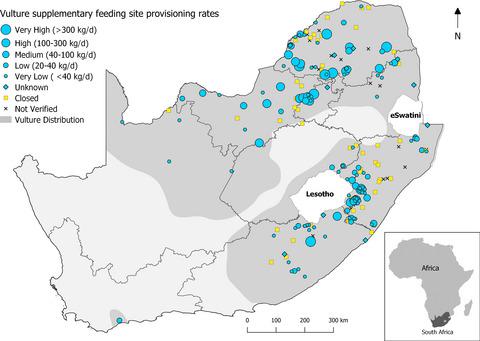当前位置:
X-MOL 学术
›
Anim. Conserv.
›
论文详情
Our official English website, www.x-mol.net, welcomes your
feedback! (Note: you will need to create a separate account there.)
Quantifying the spatial distribution and trends of supplementary feeding sites in South Africa and their potential contribution to vulture energetic requirements
Animal Conservation ( IF 2.8 ) Pub Date : 2020-01-02 , DOI: 10.1111/acv.12561 C. W. Brink 1 , A. Santangeli 1, 2 , A. Amar 1 , K. Wolter 3 , G. Tate 4 , S. Krüger 5 , A. S. Tucker 6 , R. L. Thomson 1
Animal Conservation ( IF 2.8 ) Pub Date : 2020-01-02 , DOI: 10.1111/acv.12561 C. W. Brink 1 , A. Santangeli 1, 2 , A. Amar 1 , K. Wolter 3 , G. Tate 4 , S. Krüger 5 , A. S. Tucker 6 , R. L. Thomson 1
Affiliation

|
Old world vultures are the most threatened group of raptors globally. Supplementary feeding sites (SFS) are a popular conservation tool, widely used to assist vulture populations. Despite their popularity, the impact of SFS on vultures remains largely unstudied. A lack of knowledge on the number, distribution and management of SFS is a key factor hindering such research. In this study, we compile records of SFS in South Africa and conduct questionnaires with SFS managers to characterize SFS. We identify 143 currently active SFS. Our data suggest that SFS numbers have been stable over the last decade. The average provisioning rate for all SFS was 64.6 kg day−1. Overall SFS provide an estimated 3301 tonnes of food to scavengers each year, the equivalent of 83% of the energetic needs of all vultures in the region. This contribution was highly skewed, however, with just 17% of active SFS sites providing 69% of all food. Furthermore, these resources were not equally distributed, with SFS in Limpopo, North West and Kwazulu‐Natal provinces providing 83% of the total meat provisioned. The three most common meat types provided at SFS were beef (39%), pork (33%) and game (19%). Worryingly, we found that 68% and 28% of SFS managers were unaware of the potential harmful effects of lead and veterinary drugs, respectively, which highlights potential poisoning risks associated with SFS. Examining exposure to SFS by different vulture species, we found that whilst SFS are accessible across the distribution range of vultures with large home ranges (e.g. African white‐backed and Cape vultures), those species with smaller home ranges have relatively poor accessibility. With this study, we demonstrate the potential importance, but also associated risks, of SFS to vultures in South Africa, and provide the information base to assess the impacts of this popular but as yet largely unassessed conservation tool.
中文翻译:

量化南非辅助饲养场的空间分布和趋势,及其对秃en能量需求的潜在贡献
秃鹰是全球猛禽中最受威胁的群体。辅助饲养场所(SFS)是一种流行的保护工具,广泛用于协助秃鹰种群。尽管非常流行,但SFS对秃鹰的影响仍未研究。对SFS的数量,分布和管理的了解不足是阻碍此类研究的关键因素。在这项研究中,我们汇编了南非SFS的记录,并与SFS经理进行了问卷调查以表征SFS。我们确定了143个当前活动的SFS。我们的数据表明,过去十年中SFS的数量一直稳定。所有SFS的平均供应率为64.6千克日-1。整个SFS每年估计为清道夫提供3301吨食物,相当于该地区所有秃鹰活力需求的83%。但是,这一贡献非常不平衡,只有17%的活跃SFS场所提供了69%的食物。此外,这些资源分配不均,林波波省,西北省和夸祖鲁-纳塔尔省的粮食安全特别计划提供的肉类占总供应量的83%。SFS提供的三种最常见的肉类为牛肉(39%),猪肉(33%)和野味(19%)。令人担忧的是,我们发现68%和28%的SFS管理员分别没有意识到铅和兽药的潜在有害影响,这突出了与SFS相关的潜在中毒风险。检查不同秃鹰物种对SFS的接触,我们发现,虽然在整个家庭范围内的秃鹰分布范围内都可以使用SFS(例如非洲白背和海角秃ul),但家庭范围较小的物种可及性相对较差。通过这项研究,我们证明了SFS对南非秃鹰的潜在重要性以及相关风险,并提供了信息库来评估这种流行但尚未得到评估的保护工具的影响。
更新日期:2020-01-02
中文翻译:

量化南非辅助饲养场的空间分布和趋势,及其对秃en能量需求的潜在贡献
秃鹰是全球猛禽中最受威胁的群体。辅助饲养场所(SFS)是一种流行的保护工具,广泛用于协助秃鹰种群。尽管非常流行,但SFS对秃鹰的影响仍未研究。对SFS的数量,分布和管理的了解不足是阻碍此类研究的关键因素。在这项研究中,我们汇编了南非SFS的记录,并与SFS经理进行了问卷调查以表征SFS。我们确定了143个当前活动的SFS。我们的数据表明,过去十年中SFS的数量一直稳定。所有SFS的平均供应率为64.6千克日-1。整个SFS每年估计为清道夫提供3301吨食物,相当于该地区所有秃鹰活力需求的83%。但是,这一贡献非常不平衡,只有17%的活跃SFS场所提供了69%的食物。此外,这些资源分配不均,林波波省,西北省和夸祖鲁-纳塔尔省的粮食安全特别计划提供的肉类占总供应量的83%。SFS提供的三种最常见的肉类为牛肉(39%),猪肉(33%)和野味(19%)。令人担忧的是,我们发现68%和28%的SFS管理员分别没有意识到铅和兽药的潜在有害影响,这突出了与SFS相关的潜在中毒风险。检查不同秃鹰物种对SFS的接触,我们发现,虽然在整个家庭范围内的秃鹰分布范围内都可以使用SFS(例如非洲白背和海角秃ul),但家庭范围较小的物种可及性相对较差。通过这项研究,我们证明了SFS对南非秃鹰的潜在重要性以及相关风险,并提供了信息库来评估这种流行但尚未得到评估的保护工具的影响。











































 京公网安备 11010802027423号
京公网安备 11010802027423号